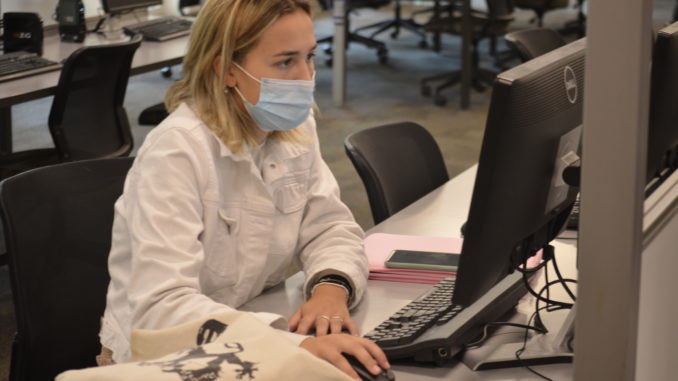
With the number of in-person classes on the rise, students, professors and administrators reflected on the biggest changes they underwent during the first half of the fall semester.
Even though the transition to the classroom has been difficult, it also reflects a slow return to normalcy on Truman State University’s campus. This year, Truman is offering a total of 1506 sections, with 184 of those classes being administered fully online. The 12.22% of classes offered fully online does not include courses administered in a hybrid format.
One of the people responsible for overseeing and deciding how the university delivered curriculum during the pandemic was Janet Gooch, executive vice president for Academic Affairs and Provost. Gooch and her staff were forced to navigate the inherent uncertainty surrounding course delivery during fall 2021.
“When we were making decisions about the fall, things were still very unknown,” Gooch said. “We didn’t have a vaccine when we were considering classes last year.”
Despite the difficulties with online course delivery, Gooch emphasized the lessons Truman has learned through the pandemic.
One of the most important lessons, Gooch said, was realizing the value of online education.
“I think there’s a place for online and in-person learning on our campus,” Gooch said. “We’ve been recently developing graduate programs that are intentionally all online because Truman sees value in offering programs to different audiences than we were once able to offer them to.”
In addition to online graduate programs, many professors teaching in-person classes have also integrated the technology we used during the COVID-19 pandemic into their classrooms. Heather Cianciola, McNair project director and assistant professor of English, said she still plans on utilizing online tools to provide more accessibility and flexibility for students.
“I prefer in-person classes, but I still feel like you can have meaningful conversations, discussions and there are even a lot of great resources to help us generate content,” Cianciola said.
The educational ramifications of online learning are not the only long lasting effects of the pandemic. Cianciola said she has noticed a sharp decline in students’ energy and emotional wellness, even with the re-introduction of in-person classes. She also suggested that students have tended to not participate as much as they did before the pandemic.
Similar to Gooch, Cianciola said he sees significant value in the virtual elements that are now part of our in-person learning experiences.
“I hope that we don’t go back to a non-virtual world. Tools like Zoom and online courses, even with their formidable barriers, enable greater educational access overall. At the end of the day, that is what Truman is all about,” Cianciola said.
Jesse Wren, a senior at Truman, echoed Cianciola’s preference for in-person learning.
For Wren, navigating the pandemic was made easier by relationship building, extra-curricular engagement and Truman’s tight knit community.
However, Wren drew attention to the logistical difficulties that being in-person brings with it. Wren was able to play an active role in several committees because of their virtual nature, but being in person has forced him to make significant adjustments to his schedule.
“Now that we’re in person, I can’t just jump on back to back meetings anymore,” Wren said.
In an academic sense, Wren and Cianciola see significant value in the conversations and experiences that the reintroduction of in-person classes has brought along with it.
From a student perspective, Wren doesn’t feel that the pandemic spoiled his college experience because of the non-educational aspects that Truman’s faculty and campus provide.
“I found that what you want out of the college experience is what you get,” Wren said. “I have still found a way to build community in multiple different organizations, stay connected with my peers and professors, so the only thing that is really different is that I’m wearing a mask now.”
Going forward, Gooch said the number of in-person classes should continue to rise. However, she was reluctant to make any firm statements because of the ever-changing nature of the pandemic, variants, vaccination rates and other complications.
